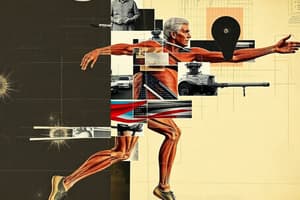Podcast
Questions and Answers
What does the field of neuromechanics primarily focus on?
What does the field of neuromechanics primarily focus on?
- Studying the biochemical processes within muscles
- Understanding human motion through body dynamics and control systems (correct)
- Analyzing external mechanical forces applied to the body
- Investigating the psychological aspects of motor learning
Which application of neuromechanics is designed for restoring movement function?
Which application of neuromechanics is designed for restoring movement function?
- Exercise prescription to limit ageing effects
- Prosthetic design
- Exercise prescription to restore lost movement function after disuse (correct)
- Exercise prescription for performance enhancement
How does MEDI258 integrate with MEDI222 in terms of focus?
How does MEDI258 integrate with MEDI222 in terms of focus?
- Focus on muscle recovery and rehabilitation strategies
- Emphasis on muscle mechanics and force production (correct)
- Study of cognitive learning and motor skills
- Concentration on cardiovascular health and endurance
Which statement correctly describes a concept related to neuromechanics?
Which statement correctly describes a concept related to neuromechanics?
What is the significance of electromyography in neuromechanics?
What is the significance of electromyography in neuromechanics?
In relation to aging, neuromechanics can be applied to which of the following?
In relation to aging, neuromechanics can be applied to which of the following?
Which muscle among the following is associated with a higher innervation number?
Which muscle among the following is associated with a higher innervation number?
Which statement accurately describes the relationship between muscle size and innervation?
Which statement accurately describes the relationship between muscle size and innervation?
Which muscle demonstrated the highest innervation number among all listed?
Which muscle demonstrated the highest innervation number among all listed?
Which muscle is associated with low dexterity and high innervation number?
Which muscle is associated with low dexterity and high innervation number?
What is the main characteristic of the First lumbrical muscle in relation to its innervation?
What is the main characteristic of the First lumbrical muscle in relation to its innervation?
Among the following, which muscle had an innervation number recorded in stillborn infants?
Among the following, which muscle had an innervation number recorded in stillborn infants?
What initiates the power stroke during the cross-bridge cycle?
What initiates the power stroke during the cross-bridge cycle?
Which component binds to calcium and triggers a structural change in actin filaments during contraction?
Which component binds to calcium and triggers a structural change in actin filaments during contraction?
What is the primary function of electromyography (EMG)?
What is the primary function of electromyography (EMG)?
During excitation-contraction coupling, what occurs immediately after the muscle fiber action potential enters the fiber?
During excitation-contraction coupling, what occurs immediately after the muscle fiber action potential enters the fiber?
Which process is closely linked to the activation of motor units for smooth muscle contraction?
Which process is closely linked to the activation of motor units for smooth muscle contraction?
What is the role of ATP in the cross-bridge cycle?
What is the role of ATP in the cross-bridge cycle?
What happens to calcium after it is released into the sarcoplasm during muscle contraction?
What happens to calcium after it is released into the sarcoplasm during muscle contraction?
Which of the following most accurately describes the relationship between EMG signals and muscle force?
Which of the following most accurately describes the relationship between EMG signals and muscle force?
What constitutes a motor unit?
What constitutes a motor unit?
Which component is primarily responsible for integrating commands from the nervous system to the muscle?
Which component is primarily responsible for integrating commands from the nervous system to the muscle?
What is the significance of the distribution of motor units in relation to muscle fiber innervation?
What is the significance of the distribution of motor units in relation to muscle fiber innervation?
What does the term 'innervation number' refer to?
What does the term 'innervation number' refer to?
Why might the innervation number be different across various muscles?
Why might the innervation number be different across various muscles?
In relation to the abductor digiti minimi muscle, what is the innervation number based on anatomical estimates?
In relation to the abductor digiti minimi muscle, what is the innervation number based on anatomical estimates?
How many motor units participate in innervating approximately 48,000 fibers in a hand muscle?
How many motor units participate in innervating approximately 48,000 fibers in a hand muscle?
What role does the alpha motor axon play in muscle innervation?
What role does the alpha motor axon play in muscle innervation?
What is the relationship between motor unit size and muscle function?
What is the relationship between motor unit size and muscle function?
What characteristic of motor units relates to their function in muscle movement?
What characteristic of motor units relates to their function in muscle movement?
Flashcards are hidden until you start studying
Study Notes
Neuromechanics
- Neuromechanics attempts to understand how body dynamics, muscles, sensory organs, and the central nervous system interact to create human movement.
Applications of Neuromechanics
- Applied to exercise prescription for performance enhancement, reducing or reversing age-related neuromuscular decline, restoring function after injury or disuse, and designing prosthetics, exoskeletons, and humanoid robots.
Neuromechanics @ UOW
- This course (MEDI258) is part of a larger framework of biomechanics courses offered at UOW, from introductory to advanced levels.
How does MEDI258 relate to MEDI222?
- Builds upon concepts from the Foundations of Biomechanics course (MEDI222), including muscle mechanics, force production, moment arms and torque, momentum, work, energy, and power, as well as analysis of movement in different situations, including fatigue, aging, and strength training.
- Expands on understanding of simple reflex control, spinal cord control of locomotion, cortical control of voluntary movement, and neural adaptations driving movement changes.
Generating Force with Muscle
- Muscle force fluctuations during fatigue: During an activity like squatting to fatigue, muscle strength diminishes due to factors such as depletion of energy stores and accumulation of waste products.
Muscle Structure/Function
- Excitation/contraction coupling: How electrical signals trigger muscle contraction.
- Muscle fiber action potential travels into a fiber, activating the sarcoplasmic reticulum.
- Calcium is released, and then reuptake into the sarcoplasm.
- Calcium binds to troponin molecules, altering the structure of the actin filament.
- ATP binds to myosin heads, allowing them to detach from actin.
Cross-Bridge Cycle
- This explains how myosin and actin interact to generate muscle force.
- Myosin head attaches to actin filament.
- ATP binds to the myosin head, detaching it from actin.
- Calcium binds to troponin, enabling myosin heads to re-attach to actin.
- ATP is hydrolyzed, initiating the power stroke (2 pN of force).
- ADP is released, returning myosin to its base state.
Measuring Muscle Activity: Electromyography (EMG)
- EMG is used to measure the electrical activity of muscles.
- Uses differential electrodes placed over a muscle.
- Captures activation of many muscle fibers at a time.
- Is related to, but not identical to, muscle force.
- Can be used to assess relative muscle activity levels over time.
Motor Units - Structure
- Motor unit: a single motor neuron plus all of the muscle fibers it innervates.
- The motor neuron is the final common pathway for motor commands, integrating signals from different levels of the nervous system and sending them to the muscle.
Motor Units - How Many in a Muscle?
- The number of motor units in a muscle varies depending on its size and function.
- Larger muscles have more motor units.
- Muscles with high dexterity have fewer motor units.
- Muscles with low dexterity have more motor units.
Motor Units - Types
- Muscle fibers are classified based on myosin heavy chain isoform.
- Type I: slow oxidative
- Type IIA: fast oxidative
- Type IIX: fast glycolytic
- Each motor unit is associated with a specific muscle fiber type.
- Type S: slow twitch, fatigue-resistant
- Type FR: fast twitch, fatigue-resistant
- Type FF: fast twitch, fatigable
Motor Units - Recruitment
- Muscle force output is controlled by the recruitment and firing rate of motor units.
- Henneman size principle: Small, slow-twitch motor units are recruited first, followed by larger, fast-twitch units as force demand increases.
- Rate coding: Force output of a single motor unit can be increased by increasing its firing rate (frequency of action potentials).
Studying That Suits You
Use AI to generate personalized quizzes and flashcards to suit your learning preferences.


